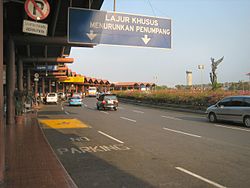Malay language
Malay is an Austronesian language predominantly spoken by Malay people in northeastern of Sumatra to the Riau Islands and its surroundings; which includes Singapore and Malay Peninsula, as well as the western and northernmost coast of Borneo (especially in Pontianak and Brunei).
| Malay | ||||
|---|---|---|---|---|
| Melayu ملايو | ||||
| Native to | ||||
| Ethnicity | Malay | |||
| Native speakers | 12 million (2007) | |||
| Language family | ||||
| Early forms: | Old Malay
| |||
| Standard forms | Standard Malay | |||
| Writing system | ||||
| Official status | ||||
| Official language in | ||||
| Recognised minority language in | ||||
| Regulated by |
| |||
| Language codes | ||||
| ISO 639-2 | ms | |||
| ISO 639-3 | zsm – Standard Malay | |||
 Countries where Malay is official or recognized | ||||
| ||||
Writing system
Malay is normally written with the Latin alphabet called Rumi. But there is also a modified Arabic alphabet that is called Jawi. Rumi is official in Malaysia and Singapore, and the Indonesian language has a different official orthography that uses also the Latin script. Rumi and Jawi are both official languages in Brunei. Efforts are currently being undertaken to preserve Jawi script and to revive its use amongst Malays in Malaysia, and students taking the Malay language examination in Malaysia have the option of answering questions using Jawi script. But the Latin alphabet is still the most commonly used script in Malaysia, both for official and informal purposes.
Historically, Malay has been written in various types of script. Before the introduction of Arabic script in the Malay region, Malay was written using Pallava, Kawi and Rencong script and are still in use today by the Champa Malay in Vietnam and Cambodia.
Malay Language Media
The Rencong alphabet, a native writing system found in central and South Sumatra. The text reads (Voorhoeve's spelling): "haku manangis ma / njaru ka'u ka'u di / saru tijada da / tang [hitu hadik sa]", which is translated by Voorhoeve as: "I am weeping, calling you; though called, you do not come" (hitu adik sa- is the rest of 4th line.
Kedukan Bukit Inscription, using Pallava alphabet, is the oldest surviving specimen of the Old Malay language in South Sumatra, Indonesia.
Final pages of the Taj al-Salatin, The Crown of Kings, a Malay "mirror for princes", copied by Muhammad bin Umar Syaikh Farid on 31 July 1824 CE in Penang in Jawi script. British Library
Indonesian road signs in Soekarno–Hatta International Airport. The blue sign reads "Lajur Khusus Menurunkan Penumpang" which means "Lane for dropping passengers only" and the small no-parking sign on the left reads "Sampai Rambu Berikutnya" which means "until next sign" in Indonesian.
Mural of Mark 1:9-11 written in Betawi language
The Alamat Langkapuri from British Ceylon (present-day Sri Lanka). Initially published between 1869 and 1870 and written in Jawi script, it is noted to be among the first Malay-language newspaper. The readership consist of the Malay-diaspora in Ceylon as well as in the Malay archipelago.
The Youth Pledge was the result of the Second Youth Congress held in Batavia in October 1928. On the last pledge, there was an affirmation of Indonesian language as a unifying language throughout the archipelago.
Indonesian speaker
Malaysian speaker
A young man speaks Kedah Malay.
References
| This language has its own Wikipedia project. See the Malay language edition. |
| This language has its own Wikipedia project. See the Malay language edition. |
- ↑ "Kedah MB defends use of Jawi on signboards". The Star. 26 August 2008. http://thestar.com.my/news/story.asp?file=/2008/8/26/nation/22168989&sec=nation. Retrieved 28 August 2021.







